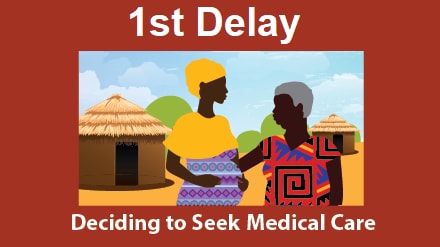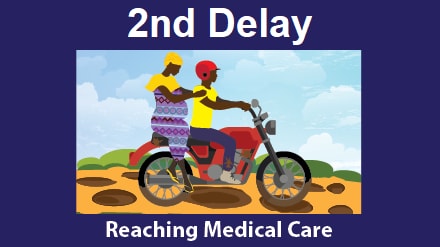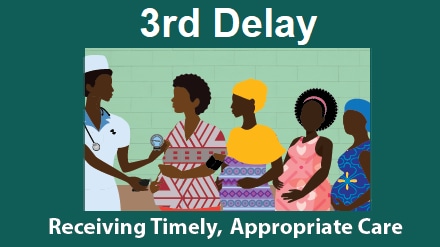Key points
The 5-year Saving Mothers, Giving Life initiative reduced maternal mortality ratios in study areas by 44% in Uganda and 41% in Zambia. It focused on the time around delivery, with a multi-system approach improving access to maternity care and the quality of care.

Overview
Preventing maternal deaths with a multi-system approach
The Saving Mothers, Giving Life (SMGL) Initiative had a bold goal: to reduce maternal deaths in low-resource settings by 50% by
- Focusing on the period around labor, delivery, and the first 48 hours postpartum, when many maternal and newborn deaths occur.
- Using a multi-system approach (improved quality of maternity care, improved access to care).
About SMGL:
- A 5-year initiative (from 2013 to 2018).
- Operated in eight study districts (four in Uganda, four in Zambia).
- Supported by a public-private partnership, including CDC. (Public: governments of Uganda, and Zambia, Norwegian Ministry of Foreign Affairs, US government. Private: Merck for Mothers, Every Mother Counts, American College of Obstetricians and Gynecologists, Project Cure) .
Was it successful?
CDC's Monitoring and Evaluation results show that the maternal mortality ratio in these districts fell by 44% in Uganda and by 41% in Zambia during this period.
How do the "3 Delays" increase mortality?
Women may experience obstetric complications when they give birth, such as hemorrhage, obstructed labor, or sepsis (infection). These complications can be life-threatening if the women also encounter one or more of the "3 Delays" in getting the care they need.
SMGL aimed to reduce the "3 Delays" by working to strengthen the whole health system serving pregnant and delivering women in the project districts so that:
- Every pregnant woman has access to clean delivery facilities with skilled care.
- Any woman experiencing a pregnancy or birth complication can reach high quality lifesaving emergency obstetric care within 2 hours.
First Delay: Delay in deciding to seek appropriate services
The pregnant woman, her family, and her community need to be able to recognize she is experiencing a complication and be able to act swiftly to get her to skilled care.
Birth preparedness, promoting facility delivery, and transportation access are needed.

Second Delay: Delay in reaching medical care
Any pregnant woman needs to be able to reach emergency obstetric and neonatal care facilities in 2 hours or less.
Access to these facilities is improved when there is emergency transportation, maternity waiting homes, and more facilities (new or upgraded) available.

Third Delay: Delay in receiving timely, appropriate care
When a woman with an obstetric complication reaches an emergency facility, she needs to receive high-quality treatment immediately.
Facilities need to have the appropriate equipment, supplies, and trained staff ready at all times.

SMGL's multi-system approach to reducing maternal deaths
Quality care requires many aspects of the health system to work well and to work together. SMGL's multi-system approach made improvements in each of the following components of maternity care:
- Skilled caregivers at birth.
- Safe health facilities for delivery.
- Having the necessary supplies and skills to provide basic and emergency obstetric services.
- Systems for communication, referral, and transportation that are available 24 hours a day, 7 days a week.
- Quality data, surveillance, monitoring, and evaluation.
SMGL made these improvements by working in a number of organizational areas, such as:
- Upgrading health facilities.
- Improving health provider skills.
- Increasing family planning availability.
To do this, SMGL worked at a number of organizational levels:
- Individual and family.
- Community.
- Individual health facility.
- Regional/district health system.
Resources
Infographics
Saving Mothers, Giving Life
The Path to Safe Motherhood
Phase one evaluation reports
Maternal and Perinatal Health Outcomes
End-of-project evaluation journal articles
SMGL: A Systems Approach to Reducing Maternal and Perinatal Deaths in Uganda and Zambia
SMGL additional findings
Rapid reduction of maternal mortality in Uganda and Zambia through the saving mothers, giving life initiative: results of year 1 evaluation
The Costs and Cost-Effectiveness of a District-Strengthening Strategy to Mitigate the 3 Delays to Quality Maternal Health Care: Results from Uganda and Zambia
Did Saving Mothers, Giving Life Expand Timely Access to Lifesaving Care in Uganda? A Spatial District-Level Analysis of Travel Time to Emergency Obstetric and Newborn Care
Materials available upon request
Reproductive Age Mortality Study
Health Facility Assessment
Pregnancy Outcomes Monitoring tools (Data extraction spreadsheets and tally sheets)
